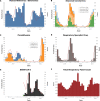The Reemergence of Seasonal Respiratory Viruses in Houston, Texas, after Relaxing COVID-19 Restrictions
- PMID: 34494861
- PMCID: PMC8557899
- DOI: 10.1128/Spectrum.00430-21
The Reemergence of Seasonal Respiratory Viruses in Houston, Texas, after Relaxing COVID-19 Restrictions
Abstract
Measures intended to limit the spread of the severe acute respiratory syndrome coronavirus 2 (SARS-CoV-2) virus at the start of the coronavirus disease 2019 (COVID-19) pandemic resulted in a rapid decrease in other respiratory pathogens. Herein, we describe the trends of respiratory pathogens in a major metropolitan health care system central microbiology reference laboratory before and during the COVID-19 pandemic, with attention to when COVID-19 mitigation measures were implemented and relaxed. During the initial lockdown period, COVID-19 was the primary respiratory pathogen detected by multiplex respiratory panels. As COVID-19 containment measures were relaxed, the first non-COVID respiratory viruses to return to prepandemic levels were members of the rhinovirus/enterovirus family. After the complete removal of COVID-19 precautions at the state level, including an end to mask mandates, we observed the robust return of seasonal coronaviruses, parainfluenza virus, and respiratory syncytial virus. Inasmuch as COVID-19 has dominated the landscape of respiratory infections since early 2020, it is important for clinicians to recognize that the return of non-COVID respiratory pathogens may be rapid and significant when COVID-19 containment measures are removed. IMPORTANCE We describe the return of non-COVID respiratory viruses after the removal of COVID-19 mitigation measures. It is important for the public and physicians to recognize that, after months of COVID-19 being the primary driver of respiratory infection, more typical seasonal respiratory illnesses have returned, and this return is out of the normal season for some of these pathogens. Thus, clinicians and the public must now consider both COVID-19 and other respiratory illnesses when a patient presents with symptomatic respiratory illness.
Keywords: COVID-19; coronavirus; influenza; masking; parainfluenza virus; respiratory syncytial virus.
Figures

References
-
- Olsen SJ, Azziz-Baumgartner E, Budd AP, Brammer L, Sullivan S, Pineda RF, Cohen C, Fry AM. 2020. Decreased influenza activity during the COVID-19 pandemic—United States, Australia, Chile, and South Africa, 2020. MMWR Morb Mortal Wkly Rep 69:1305–1309. doi:10.15585/mmwr.mm6937a6. - DOI - PMC - PubMed
-
- Chu DK, Akl EA, Duda S, Solo K, Yaacoub S, Schünemann HJ, COVID-19 Systematic Urgent Review Group Effort (SURGE) study authors . 2020. Physical distancing, face masks, and eye protection to prevent person-to-person transmission of SARS-CoV-2 and COVID-19: a systematic review and meta-analysis. Lancet 395:1973–1987. doi:10.1016/S0140-6736(20)31142-9. - DOI - PMC - PubMed
-
- Long SW, Olsen RJ, Christensen PA, Subedi S, Olson R, Davis JJ, Saavedra MO, Yerramilli P, Pruitt L, Reppond K, Shyer MN, Cambric J, Finkelstein IJ, Gollihar J, Musser JM. 2021. Sequence analysis of 20,453 severe acute respiratory syndrome coronavirus 2 genomes from the Houston Metropolitan Area identifies the emergence and widespread distribution of multiple isolates of all major variants of concern. Am J Pathol 191:983–992. doi:10.1016/j.ajpath.2021.03.004. - DOI - PMC - PubMed
-
- Musser JM, Olsen RJ, Christensen PA, Long SW, Subedi S, Davis JJ, Gollihar J. 2021. Rapid, widespread, and preferential increase of SARS-CoV-2 B.1.1.7 variant in Houston, TX, revealed by 8,857 genome sequences. medRxiv. doi:10.1101/2021.03.16.21253753. - DOI
-
- Long SW, Olsen RJ, Christensen PA, Bernard DW, Davis JR, Shukla M, Nguyen M, Ojeda Saavedra M, Cantu CC, Yerramilli P, Pruitt L, Subedi S, Hendrickson H, Eskandari G, Kumaraswami M, McLellan, Musser JS. 2020. Molecular architecture of early dissemination and evolution of the SARS-CoV-2 virus in metropolitan Houston, Texas. bioRxiv. doi:10.1101/2020.05.01.072652. - DOI - PMC - PubMed
MeSH terms
LinkOut - more resources
Full Text Sources
Medical
Research Materials
Miscellaneous

